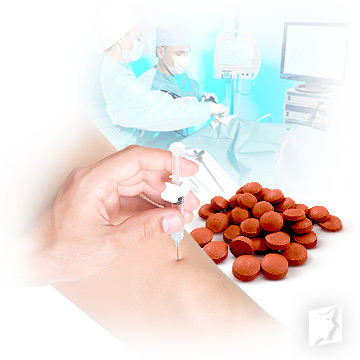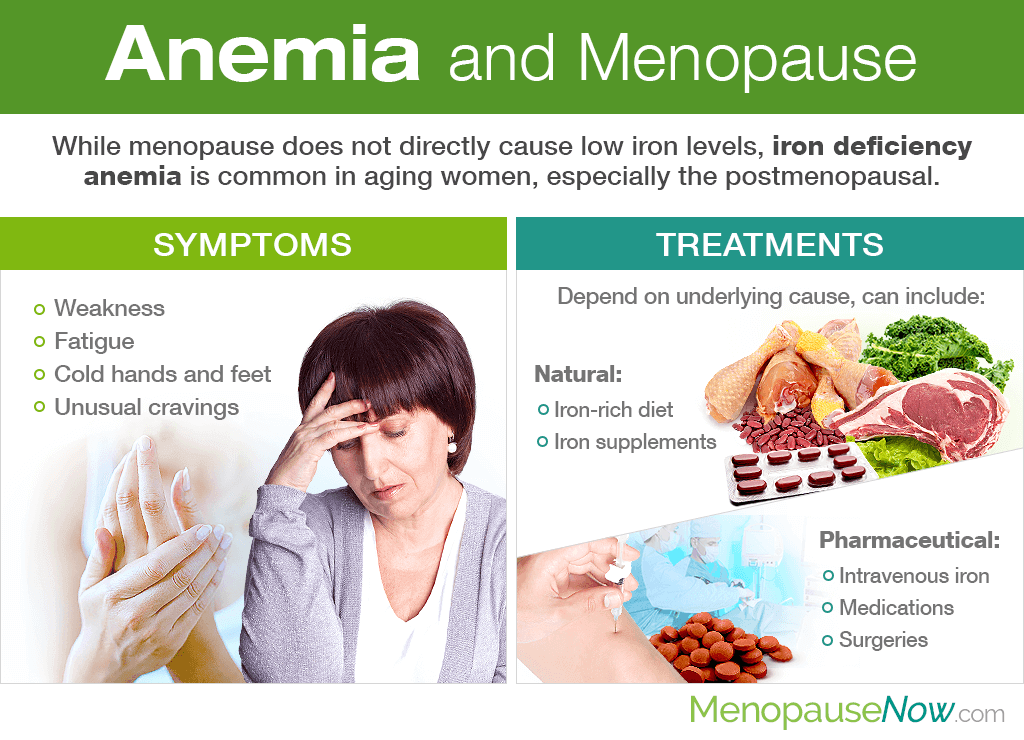Anemia is a health condition in which the body does not have an adequate number of red blood cells to carry enough oxygen to tissues, making sufferers feel constantly tired and weak. While there are many forms of anemia, iron deficiency anemia is the most common for women, especially for those who are postmenopausal.
Continue reading to learn more about anemia and menopause so that you can get on the right track to optimal energy levels and an improved quality of life.
Can Menopause Cause Low Iron?
Passing through the menopausal transition does not directly cause low iron levels that can lead to iron deficiency perimenopausal or postmenopausal anemia.
In women of all ages, having low levels of the mineral in the body is usually caused by inadequate iron consumption.
Did you know?
As women age, their need for iron decreases. Before menopause, non-vegetarian women need about 18 mg of iron each day. After menopause, this number decreases to 8 mg of iron a day.
Nevertheless, iron deficiency anemia during or after menopause can also be due to blood loss from heavy menstrual bleeding, characteristic of irregular periods during perimenopause; ulcers; cancer; health conditions or surgeries that cause nutrient malabsorption, like Crohn's disease, celiac disease, or gastric bypass; or frequent use of over-the-counter pain relievers, like aspirin.
Two recent studies observing iron deficiency anemia in postmenopausal women, specifically, credited inadequate nutrient intake and malabsorption of iron as prevalent causes of the health condition.
What are the Symptoms of Iron Deficiency Anemia?

The symptoms of iron deficiency anemia are universal across all age groups, and they include:
- Weakness (very common)
- Fatigue (very common)
- Dizziness or lightheadedness
- Headaches
- Cold hands and feet
- Shortness of breath
- Pale or yellow “sallow” skin
- Rapid or irregular heartbeats
- Unusual cravings for ice, very cold drinks, or non-food items (dirt, paper, etc.)
- Brittle nails
- Chest pain
- And more
Keep in mind that as the anemia progresses, so does the severity of symptoms.
Treatments for Iron Deficiency Anemia

The main goals of anemia treatment are to increase red blood cell count, treat the underlying cause, prevent further complications, and relieve symptoms to improve one's overall quality of life.
As such, depending on the underlying cause of the iron deficiency anemia during menopause, there are various treatment choices women can pursue.
For women who have an inadequate intake of iron, their first line of action would be to consume an iron-rich diet.
An iron-rich diet should be filled with a healthy balance of meat (beef, pork, lamb, and organ meats); poultry (duck, turkey, chicken); leafy greens like collard or turnip greens, broccoli, or kale; legumes; fish; and iron-enriched food products that include pastas, cereals, grains, and more.
Alongside iron-rich foods, women should also aim to consume adequate amounts of vitamin B12 from meat, dairy products, and fortified options as well as folate, found in dark green leafy vegetables, legumes, peanuts, fruits, and more. A deficiency in both can cause also lead to anemia. Also, do not forget vitamin C to increase iron absorption.
Depending on the severity of the anemia, their doctors may also recommend iron supplements in the form of elemental iron. Beware that supplementation can cause higher levels of stored iron in the body, which has been scientifically found to lead to a greater incidence of heart disease, especially in postmenopausal women.

Whereas, for women who are suffering from malabsorption that is causing their iron deficiency anemia, intravenous iron may be necessary until the exact cause of the malabsorption is properly addressed.
Furthermore, if low iron during or after menopause is due to blood loss from polyps, cancer, tumors, heavy periods, or another source, medications or surgeries may be ensued as seen fit by you and your doctor.
Along these lines, if iron deficiency anemia is caused by heavy periods as women are transitioning out of their fertile years, they are recommended to pursue menopause symptoms treatments that will foster overall endocrine system health. These natural and effective methods will not only target the irregular periods causing anemia, but also a myriad of other menopause symptoms that could be causing upset, such as mood swings, hot flashes, night sweats, vaginal dryness, and more.
Key Takeaways
Anemia is a multifaceted health condition that can rear its ugly head in many forms, with iron deficiency anemia being the most common for women as they transition through and out of their reproductive years. While often caused by insufficient iron consumption, iron deficiency anemia that causes symptoms of fatigue, weakness, cold sensitivity, and more can also be due to heavy menstrual bleeding, ulcers, cancer, and malabsorption, among other factors. Treatment will depend upon the underlying cause and ranges from an iron- and nutrient-enriched diet to iron supplements, medications, and surgeries. Do not let the condition progress and further deprive your body of the life-giving oxygen it needs. Take action today!
Sources
- American Society of Hematology. (n.d.). Iron-Deficiency Anemia. Retrieved June 4, 2019, from https://www.hematology.org/Patients/Anemia/Iron-Deficiency.aspx
- John Hopkins Medicine. (n.d.). Introduction to Menopause. Retrieved June 4, 2019, from https://www.hopkinsmedicine.org/health/conditions-and-diseases/introduction-to-menopause
- Khansa, Q. (2015). Malabsorption of iron as a cause of iron deficiency anemia in postmenopausal women. Pakistan Journal of Medical Sciences, 31(2), 304-308. doi: 10.12669/pjms.312.6462
- Mayo Clinic. (2011). Iron Supplementation Typically Not Recommended for Postmenopausal Women. Retrieved June 4, 2019, from https://newsnetwork.mayoclinic.org/discussion/iron-supplementation-typically-not-recommended-for-postmenopausal-women/
- National Institutes of Health. (2011). Your Guide to Anemia. Retrieved June 4, 2019, from https://www.nhlbi.nih.gov/files/docs/public/blood/anemia-yg.pdf
- Office on Women's Health. (2019). Iron-deficiency anemia. Retrieved June 4, 2019, from https://www.womenshealth.gov/a-z-topics/iron-deficiency-anemia
- Thomson, C.A. et al. (2011). Nutrient intake and anemia risk in the women's health initiative observational study. Journal of the American Dietetic Association, 111(4), 532-541. doi: 10.1016/j.jada.2011.01.017
- Tussing-Humphreys, L. & Braunschweig, C. (2011). Anemia in Postmenopausal Women: Dietary Inadequacy or Nondietary Factors? Journal of the American Dietetic Association, 111(4), 528-531. Retrieved June 4, 2019, from http://www.andjrnl.org/pb/assets/raw/Health%20Advance/journals/jand/yjada_pc_111_4b.pdf

